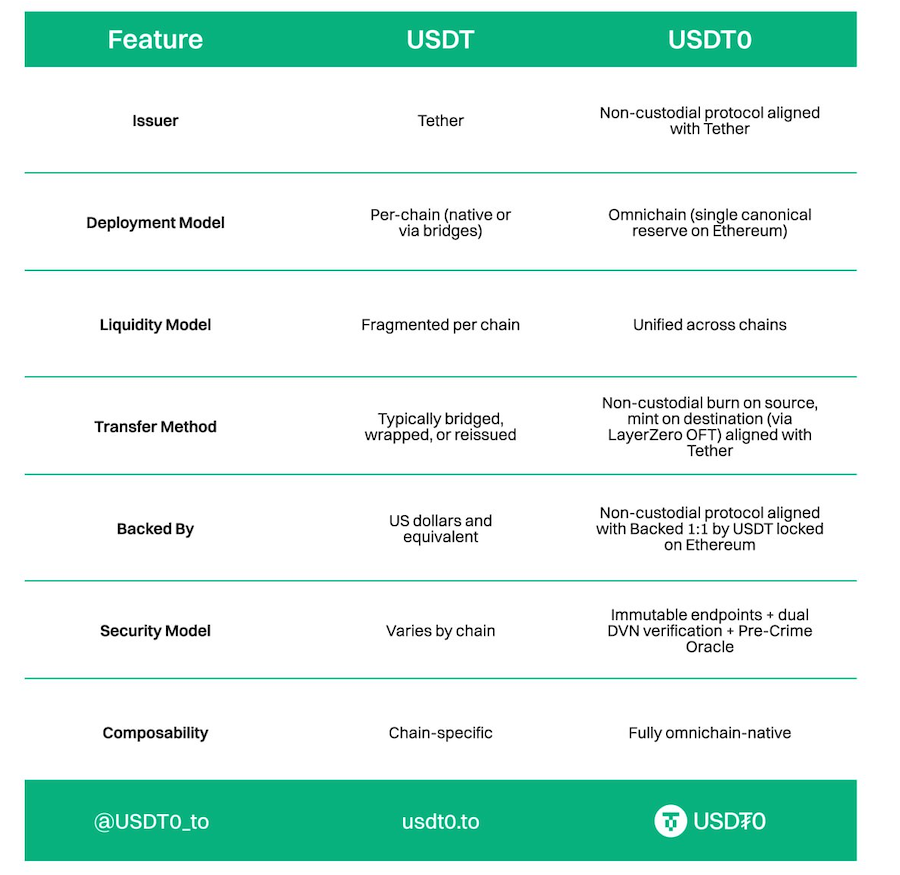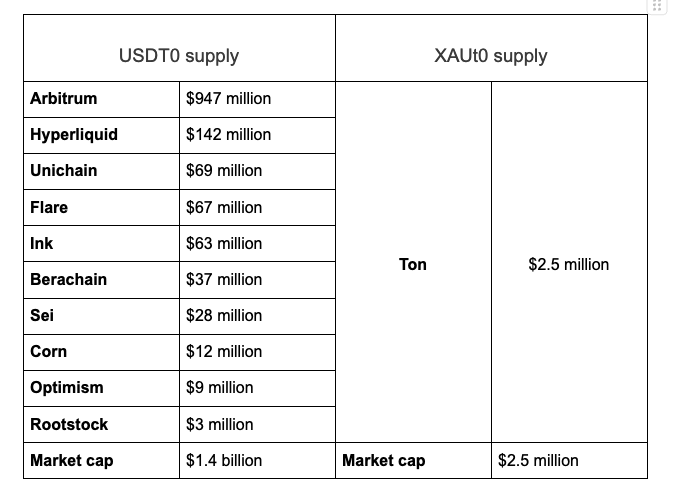USDT0 Polygon integration makes USDT0 and XAUt0 live on Polygon, adding omnichain liquidity and native gold-backed rails. The deployment enhances cross-chain USDT flows across 12 networks, improves DeFi and payments access on Polygon, and increases interoperability for stablecoin transfers.
-
USDT0 live on Polygon — 12th supported network for omnichain USDT.
-
XAUt0 reaches Polygon as its third blockchain integration, following TON and HyperEVM.
-
USDT0 market cap rose to nearly $1.6 billion; XAUt0 sits near $2.5 million (CoinGecko data).
USDT0 Polygon integration expands omnichain USDT and XAUt0 to Polygon, boosting interoperability and liquidity. See implications for stablecoin rails and DeFi adoption.
USDT0 expands to 12 networks with Polygon integration, while XAUT0 grows following its TON debut and HyperEVM integration.
Polygon, a multi-chain scalability platform, upgraded to the USDT0 standard, the unified liquidity network that introduced the omnichain versions of Tether’s USDT and XAUT.
USDT0 (USDT0) and XAUt0 (XAUt0), cross-chain liquidity tokens enabled by LayerZero’s Omnichain Fungible Token architecture, are launching on the Polygon blockchain, Everdawn Labs announced to Cointelegraph on Wednesday.
The integration marks a milestone for XAUt0, with Polygon becoming its third blockchain integration following XAUt0’s debut on TON and Hyperliquid’s HyperEVM.
For USDT0, Polygon becomes the 12th supported blockchain, reflecting the stablecoin’s design to provide the “interoperability backbone” for Tether USDt (USDT), USDT0 co-founder Lorenzo R told Cointelegraph.

Tether USDt (USDT) versus USDT0 (USDT0). Source: USDT0
What are USDT0 and XAUt0?
USDT0 and XAUt0 are omnichain token standards that mirror existing Tether assets across multiple blockchains by minting tokens when underlying USDT or XAUT are deposited into a LockBox contract on Ethereum. They are not separate asset reserves; instead, they enable cross-chain access to the same underlying USDT and XAUT liquidity.
USDT0 launched in January 2025 as an omnichain layer for Tether USDt, and XAUt0 followed shortly after. These tokens use LayerZero-type OFT mechanics to move liquidity without altering the underlying asset backing model.
How does USDT0 work on Polygon?
USDT0 operates by minting omnichain representations when USDT is locked on an origin chain (Ethereum acts as the LockBox). Polygon’s integration means wallets and DeFi protocols on Polygon can now use USDT0 natively, with the same supply tracked across supported networks.
Polygon’s existing USDT supply (PoS USDT) will be migrated into the USDT0 network without changing the core contract address, according to Lorenzo R. Polygon’s upgrades — including AggLayer and the Bhilai hardfork — provide throughput and fee characteristics that support high-volume stablecoin rails.

USDT0 and XAUt0 supply and market capitalization as of Wednesday. Source: USDT0, CoinGecko
Why did USDT0 choose Polygon?
USDT0’s expansion to Polygon is driven by liquidity, wallet base and ecosystem strength. Polygon hosts over $1 billion in USDT liquidity and exceeds 6 million wallets, positioning it as a major hub for stablecoin payments, DeFi and enterprise adoption.
Since January, USDT0’s market capitalization climbed to nearly $1.6 billion in two months, while XAUt0’s market cap sits near $2.5 million, per CoinGecko data. Tether’s USDT overall surpassed $167 billion in mid-August, and XAUT crossed a $1 billion milestone on Aug. 8.
What does this mean for developers and users?
Developers gain native omnichain liquidity for payments and DeFi primitives on Polygon. Users benefit from lower friction cross-chain transfers, and institutions can access gold-backed rails (XAUt0) in a widely adopted environment. The integration streamlines stablecoin operations without changing the underlying peg or reserve model.
Frequently Asked Questions
How do USDT0 and XAUt0 differ from traditional stablecoins?
USDT0 and XAUt0 are omnichain representations that mirror existing assets by minting tokens when the underlying USDT or XAUT is locked on Ethereum. They enable seamless cross-chain transfers without creating new reserve structures.
Can I use XAUt0 for gold-backed liquidity on Polygon?
Yes. XAUt0 introduces native gold-backed liquidity to Polygon, enabling DeFi and payments use cases that require gold-token rails while retaining the original asset’s backing model.
Key Takeaways
- Omnichain expansion: USDT0 is now live on Polygon, its 12th chain, broadening cross-chain USDT access.
- Gold-backed rails: XAUt0 reaches Polygon as its third integration, bringing native gold liquidity to a major DeFi hub.
- Practical impact: Developers and users gain lower-friction transfers, expanded liquidity, and improved payment rails on Polygon.
Conclusion
This Polygon integration cements USDT0 and XAUt0 as growing omnichain liquidity standards, scaling USDT access across 12 networks and introducing gold-backed liquidity to Polygon. Expect accelerated stablecoin utility in DeFi and payments as ecosystems adapt; follow COINOTAG for updates and technical details.
Publication date: 2025-08-27. Sources referenced as plain text: Everdawn Labs announcement, LayerZero technology notes, CoinGecko market data, Tether supply reports, Polygon upgrade documentation, statements to Cointelegraph.
